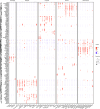Spatial transcriptomics identifies molecular niche dysregulation associated with distal lung remodeling in pulmonary fibrosis
- PMID: 39901013
- PMCID: PMC11906353
- DOI: 10.1038/s41588-025-02080-x
Spatial transcriptomics identifies molecular niche dysregulation associated with distal lung remodeling in pulmonary fibrosis
Abstract
Large-scale changes in the structure and cellular makeup of the distal lung are a hallmark of pulmonary fibrosis (PF), but the spatial contexts that contribute to disease pathogenesis have remained uncertain. Using image-based spatial transcriptomics, we analyzed the gene expression of 1.6 million cells from 35 unique lungs. Through complementary cell-based and innovative cell-agnostic analyses, we characterized the localization of PF-emergent cell types, established the cellular and molecular basis of classical PF histopathologic features and identified a diversity of distinct molecularly defined spatial niches in control and PF lungs. Using machine learning and trajectory analysis to segment and rank airspaces on a gradient of remodeling severity, we identified compositional and molecular changes associated with progressive distal lung pathology, beginning with alveolar epithelial dysregulation and culminating with changes in macrophage polarization. Together, these results provide a unique, spatially resolved view of PF and establish methods that could be applied to other spatial transcriptomic studies.
© 2025. The Author(s).
Conflict of interest statement
Competing interests: J.A.K. reports grants/contracts from Boehringer Ingelheim and Bristol Myers Squibb, stock options from APIE Therapeutics and consulting fees from ARDA Therapeutics. R.W. reports consultant fees from Genentech and Boehringer Ingelheim. T.S.B. reports grants/contracts from Boehringer Ingelheim, Bristol Myers Squibb and Morphic. The other authors declare no competing interests.
Figures
















Update of
-
Image-based spatial transcriptomics identifies molecular niche dysregulation associated with distal lung remodeling in pulmonary fibrosis.bioRxiv [Preprint]. 2023 Dec 17:2023.12.15.571954. doi: 10.1101/2023.12.15.571954. bioRxiv. 2023. Update in: Nat Genet. 2025 Mar;57(3):647-658. doi: 10.1038/s41588-025-02080-x. PMID: 38168317 Free PMC article. Updated. Preprint.
References
-
- Richeldi, L. et al. Efficacy and safety of nintedanib in idiopathic pulmonary fibrosis. N. Engl. J. Med.370, 2071–2082 (2014). - PubMed
-
- King, T. E. Jr. et al. A phase 3 trial of pirfenidone in patients with idiopathic pulmonary fibrosis. N. Engl. J. Med.370, 2083–2092 (2014). - PubMed
-
- Simon, M., Potchen, E. J. & LeMay, M. (eds). Frontiers of Pulmonary Radiology pp. 102–141 (Grune & Stratton, 1969).
MeSH terms
Grants and funding
- R01HL160551/U.S. Department of Health & Human Services | NIH | National Heart, Lung, and Blood Institute (NHLBI)
- W81XWH1910415/United States Department of Defense | United States Army | Army Medical Command | Congressionally Directed Medical Research Programs (CDMRP)
- GNT1195595/Department of Health | National Health and Medical Research Council (NHMRC)
- R01HL145372/U.S. Department of Health & Human Services | NIH | National Heart, Lung, and Blood Institute (NHLBI)
- HL158906/U.S. Department of Health & Human Services | NIH | National Heart, Lung, and Blood Institute (NHLBI)
- HL126176/U.S. Department of Health & Human Services | NIH | National Heart, Lung, and Blood Institute (NHLBI)
- U01 HL175444/HL/NHLBI NIH HHS/United States
- U01HL175444/U.S. Department of Health & Human Services | NIH | National Heart, Lung, and Blood Institute (NHLBI)
- I01 BX002378/BX/BLRD VA/United States
- R01HG011886/U.S. Department of Health & Human Services | NIH | National Human Genome Research Institute (NHGRI)
- R01 HL175555/HL/NHLBI NIH HHS/United States
- R01 HL145372/HL/NHLBI NIH HHS/United States
- P01 HL172729/HL/NHLBI NIH HHS/United States
- P01HL092870/U.S. Department of Health & Human Services | NIH | National Heart, Lung, and Blood Institute (NHLBI)
- GNT1162829/Department of Health | National Health and Medical Research Council (NHMRC)
LinkOut - more resources
Full Text Sources
Medical

